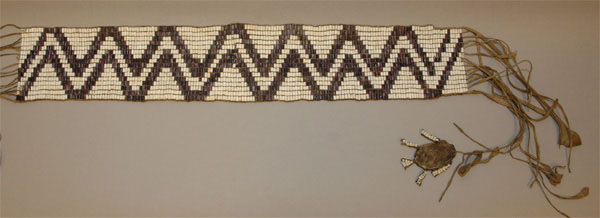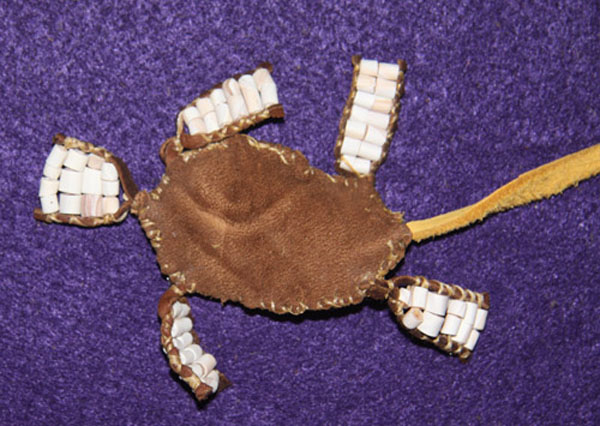Photographs (left to right): Orange Park, Florida; Little Talbot Beach, Florida; Cedar Key, Florida
Wampum Belt Archive
Iroquois Belt With Beaver Pouch


BLM Ethno 1931.12
From Hemming (1925)


Reproduction R. D. Hamell
Original Size: |
Beaded Length: 24.75 inches. Width: 4.25 inches. Rows: 16 reduced to 14 on upper right. |
Reproduction: |
Beaded Length: 31.0 inches. Width: 7.2 inches. Length w/fringe: 56 inches |
Beads: |
Total Beads: 2,704. White: 1,580. Purple: 1,124. Turtle disc beads for legs, head and tail |
Materials: |
Warp: Leather. Weave: Sinew. |
Description:
Arthur Hemming (1925) described this unusual belt and included the above photograph. "In the accompanying illustration is figured a fine Wampum belt which has recently come into my possession. "The shell belt, apart from the ends of hide, measures 24 3/4 inches long and 4 1/2 inches broad. It consists of 2,696 beads in 16 rows on a woof of thread with a warp of hide, of which 1,580 are white beads and 1,110 are purple. At the end of one of the leathern thongs is a small pouch in the form, apparently, of a tortoise, in which presumably a charm was carved. "There is, of course, a considerable literature on the subject of Wampum, some of the papers containing a interesting illustrations and it may be concenient if I give the following references, which, without being an exhaustive list, furnish a good deal of information:-" Museum Tradescantium or a Collection of Rarities preserved at Lambeth, near London, by John Tradescant. London, MDCLVI. Catalogue and Description of the Natural and Artificial Rarities belonging to the Royal Society and preserved at Gresham College, London. 1681. Art in Shell, by W. H. Holmes. 2nd Ann. Rep. Bureau of Ethnology. Washington, 1883. Four Huron Wampum Records, by Horatio Hale. J. Anth. Inst. Vol. XXXI, 1897, p. 244. The Origin of Wampum, by D. I. Bushnell, Junr. J. Anth. Inst. Vol. XXXVI, 1906, p. 172. Flint Chips, by Edward T. Stevens, Hon. Curator, Blackmore Museum, 1870, p. 454. "The chevron pattern in the example figured indicates, apparently beyond doubt, that the belt belonged to the Iroquois Confederacy. Mr. Hale, who first brought forward this point in 1884, states that the origin and meaning of the oblique band were well understood among the Indian tribes, and in the paper referred to above, Four Huron Wampum Records, he produces valuable corroboration of his statement by the important authority of two chiefs well versed in Iroquois tradition, G. H. M. Johnson (Onwanonsyshon), the Government interpreter, and John Buck (Skanawati), the official keeper of the wampum, whose father, grandfather, and great grandfather had held the same office. "Among the Iroquois wampum beads were used chiefly for religious purposes and by way of ratification of laws and treaties."British Museum Description:
Wampum belt, with a white ground, and two parallel zig-zag lines of purple wampum, three beads in width. Most of the length of the belt is 16 beads wide; however at one end, 12 beads in from the end, the number of skin warps is reduced from 17 to 15. At this point one of the purple lines is reduced in width from three to two beads. The skin warps form fringes at both ends; the end with the reduced number of warps also has attached an oval skin zoomorphic feature, with a tail and four limbs indicated by skin tabs holding thin white discoidal shell beads. The other end seems to finish with the full 17 skin warps; but abrasions to these warps suggest the shadows of wefts, now missing with the beads from that end section. There may also be weft shadows on the warp-fringe at the end with the zoomorphic feature. The purple zig-zag lines touch the top edge of the belt 7 times, and the bottom 8 times. The belt is about 170 beads long. One or two beads are missing.
Exchanged Arthur G. Hemming Collection.
NOTE:
The Beaver pouch legs and tail are composed of small shell disc beads. In reconstructing the turtle artificial wampum was used.
Reference:
Hemming, Arthur G. 1925. A Notable Wampum Belt. Man, Vol. 25 (Sept.), pp. 130-131.
Stolle, Nickolaus. 2016. Talking Beads: The history of wampum as a value and knowledge bearer, from its very first beginnings until today. Hamburg, Germany. ISSN 1437-7837
 |
 |
 |
 |
 |
 |
 |
 |
|---|